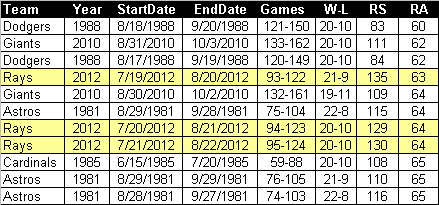
Sports on Earth debuted yesterday and featured a Q&A I did with W.K. Stratton, author of a fine new biography of Floyd Patterson. Stratton is the author of four other books including Dreaming Sam Peckinpah. He also edited Splendor in the Short Grass, a terrific collection of Grover Lewis’ non-fiction writing.
In our chat over at Sports on Earth, Stratton–who goes by the name Kip–and I talk about Patterson’s relationship with Muhammad Ali. But there’s far more to Patterson’s career than his two fights with Ali.
So, dig in, and please enjoy the rest of our conversation.

Bronx Banter: Patterson has long been a favorite of writers like W.C. Heinz and especially, Gay Talese. Yet there haven’t been so many major biographies on his life. What drew you to writing about him?
Kip Stratton: In the mid-1970s, I took a college class with my mentor, Harry Ebeling, called Nonfiction Prose of Contemporary America. It was, in essence, a class in the New Journalism. This class introduced me to the writing of Gay Talese. One of the pieces I studied in that class was Talese’s masterpiece from Esquire, “The Loser,” which was about Patterson.
BB: Did you following boxing at that time?
KS: Oh, yeah. I was a boxing fan since I was a kid. Boxing was in a kind of golden age, which probably started around the time of the Patterson-Johansson rivalry and lasted until, say, the Leonard-Hagler fight–which, incidentally, I believe Hagler won–a quarter of a century later. Although Muhammad Ali is the best known there were many terrific boxers were during that time, including Patterson. But I didn’t know how complicated Patterson was until I read that Talese piece. After that, I picked up more and more about Patterson here and there over the years, all of it interesting. In 1988, I met him, briefly, at a celebration marking the centennial of Jim Thorpe’s birth. Something about him in person seemed compelling and that increased my fascination with him. Eventually I read his autobiography, Victory Over Myself, which appeared at the peak of his career and I was blown away by what I read. Then, Thomas Hauser’s authorized biography of Ali appeared, which included a quote from Ali in which he listed Patterson with Liston, Foreman, and Frazier as the best he ever fought. Patterson, but not Ken Norton. Patterson, but not Larry Holmes. Patterson, but not Archie Moore. Ali said Patterson had the best boxing skills of any fighter he met in the ring. That pretty well cinched it for me. I knew I wanted to write about him someday.
BB: Can you talk about the work Talese did on Patterson, both for The New York Times and Esquire and how that influenced your thinking on the fighter.
KS: Talese joined The Times as a sportswriter after he served a hitch in the Army; earlier, he’d had a job on the Times as a copyboy following his graduation from the University of Alabama. As I recall, he told me he intentionally targeted a job in the sports department because it would allow him to employ more stylistic freedom than other sections of the paper, which were very much locked into “Old Gray Lady” rules of writing. He said he admired what was going on in the pages of some of the other newspapers in the city at the time, in particular The New York Herald-Tribune. The sports pages of the Times would give him the same leeway writers at these other papers had. I read many articles he wrote for the Times’ sports section. They were experimental as hell for that paper. I remember one about the future light heavyweight champion, and future author, José Torres. The profile did not give Torres’ name until the last sentence! So Talese was doing this wonderful sort of creative nonfiction for the Times. To be sure, much of it was immature compared to the masterpieces he would later write. But it was interesting. So, here you have Talese, interested in taking this whole new approach to sports writing and he runs into Floyd Patterson, a whole different sort of boxing champion.
BB: It was as if they were made for each other.

KS: Gay wrote more than four dozen bylined Times pieces about Patterson that I found. I’d never met Talase prior to starting research on the book, but he was nice enough to offer me some time for an interview after I approached him via a mutual acquaintance.
BB: You went to his brownstone here in New York?
KS: I arrived at Gay’s house on the Upper East Side on a day when he suddenly had crushing deadlines of his own. But he granted me time. I think he was impressed that I had dug up all those old Times articles. He was an absolute gentleman–of course attired in finely tailored clothes. He presented me with an inscribed copy of his newest book, which I totally did not expect. We talked and talked, not just about Patterson and D’Amato and company, but about Norman Mailer and James Baldwin and John Gregory Dunne and two of Gay’s great friends, David Halberstam and Ben Gazzara.
BB: Wow, I knew he’d been friends with Halberstam but not Gazzara.

KS: Yeah, Talese and Halberstam were friends from when they came to know each other as young reporters on the Times. Gay thought Halberstam was the greatest reporter of their generation, and I think he’s undoubtedly right about that. Gay told me that he and Gazzara followed the fights together, among other things. I also read a quote of Talese’s in which he said something like Gazzara, once he became prominent as an actor, let a whole generation know it was okay to be Italian-American. Something like that. It would have been great to have hung out with Talese and Gazzara to listen to them talk about boxing.
BB: And women. Where’s Casavetes when yo need him?
KS: Talese invited me downstairs to his basement office and showed me his archives. Like Mailer, he’s kept everything. Using large sheets of paper, he storyboards his articles as if they are three-act dramas. He showed me his actual storyboard for “Frank Sinatra Has a Cold,” which some of us think is the best magazine article ever written by an American. And he showed me the storyboard for “The Loser,” that piece I studied in Harry’s class all those years before. I was flabbergasted to actually see that relic from all those years ago. Talese and I also talked about his collaboration with Patterson for the Esquire article in which Floyd called for people to try to understand Muhammad Ali, not just jeer him, one of the first sympathetic Ali articles to run in a mainstream magazine. So I felt as if I had Talese looking over my shoulder the whole time I worked on this book. You know, this notion of, You better not fuck this up because there are high expectations whenever you take up the subject matter of Patterson.
BB: And he wasn’t alone, right?
KS: Talese, yes, but also Heinz, Mailer, Baldwin, Hamill, Oates, Schulberg–writers of that caliber. So I felt as if I had a standard to meet. Beyond that, Gay gave me a lot of insight into the Patterson saga through his comments in the interview, in particular about D’Amato, a character who merits a great deal of examination.
BB: Patterson had an unusual sensitivity and honesty for a fighter of his caliber, didn’t he?

KS: Let’s start with the instructions given by the referee before the opening bell. Nowadays, this is the time for the absurd exercise in posturing known as the stare-down. It wasn’t quite like it is now in Patterson’s day, but it was still expected that a fighter look the man he was going to battle in the eye. Patterson never did that. He stared at the other guy’s feet. He couldn’t look into the eyes of someone he was getting ready to hurt. If he did that, he wouldn’t be able to fight. He cradled Ingemar Johansson’s head after he knocked Ingo out. He helped an opponent recover his mouthpiece after he, Floyd, knocked it out.
BB: He was also candid, especially with Talese.
KS: Patterson was perhaps the most eloquent champion ever when it came to mining deep feelings and expressing them. He spoke honestly about fear, about cowardice — he described himself as a coward once. At the same time, he was reclusive and seemed to like to stay silent most of the time. He was not comfortable around people, an introvert, yet he did as much charitable work as any champion in history. He lived a conservative lifestyle in that he didn’t drink or do drugs or make the party scene very much, and he held conservative stances about other things, yet he was an early and outspoken liberal when it came to the civil rights movement. He lent his name and gave money to desegregation causes. He went to Alabama with Martin Luther King. He was often, to quote Kris Kristofferson, a walking contradiction.
BB: Patterson’s accomplishments in the ring tend to be overlooked these days. How much of that is due to the huge impression that Ali left?
KS: Patterson was the bridge between Rocky Marciano and Ali. The year Patterson won the heavyweight title, you had Humphrey Bogart appearing in The Harder They Fall. The year Patterson fought his last pro fight, you had Ron O’Neal appearing in Super Fly. Because of this, it’s hard to really associate Patterson with an era in the way you can a Dempsey or a Louis, and I think that’s allowed him to slip through the cracks to a certain extent.
BB: He gets lost.

KS: Absolutely, the light of Patterson gets lost in the glare of Ali. Patterson brings speed into the heavyweight ring that no one had ever seen before, revolutionizing the possibilities for a heavyweight fighter. But then Ali shows up with hand speed that matches Floyd’s and has even faster ring mobility and is taller and weighs more. Makes it easy to overlook Patterson. Floyd is good in interviews, eloquently giving well thought out answers. Ali takes control of interviews, makes them his own, makes them funny, makes them memorable for years to come. Patterson’s a good looking guy. Ali has movie-star good looks, one of the handsomest men to grace the public stage during the 20th century. Patterson has great wins over Moore and Johansson, but Ali has monumental victories over Liston, Frazier, and Foreman, and, indeed, Floyd himself. Mailer writes a significant article about Patterson but writes a significant book about Ali. On and on. The Greatest was and is The Greatest. But I think enough — or more than enough — has been written about him. I think it’s time to look at some of these other figures. Patterson. Joe Frazier. And so on. You go to a bookstore, and often the only boxing titles you see are about Ali. That’s not right. Elvis was the king of rock-and-roll, but that doesn’t mean that Buddy Holly and Little Richard aren’t damned significant figures. So be it with Floyd Patterson.
BB: What is it about stars of the 1950s and early ’60s being forgotten?
KS: Well, again, I think Ali has something to do with it. People became so fixated with him. We’ve now had a couple of generations of American boxers come along, many of whom don’t know how to keep their hands up or are otherwise lacking in boxing fundamentals because Ali didn’t do it that way. But they’re pretty good at pulling off ring antics of some sort. This is part of the downside of the Ali legacy. Ali became sloppy about staying in shape–of course I’m talking about fighting shape here–in the second part of his career, and that became part of the negative legacy too. And one thing Ali did was that he made the fight be something more than the fight. Often it seemed that the sideshow was more important to the fans than the fight itself. That’s carried over to subsequent generations of fighters.

BB: How so?
KS: Floyd Mayweather is a brilliant boxer, but it seems that his fans are more interested in the gangsta production surrounding the fight than the fight itself. Well, Mayweather understands that expectation and delivers time after time. The fights of the pre-Ali era was something entirely different. Flourishes occurred here and there among the boxers, and fairly often when you talk about Archie Moore, who was a different sort of character for the 1950s, but the fight itself was the thing. Beau Jack headlined the Garden 21 times during the 1940s and ’50s and brought no show except his boxing skills. That was enough for the time. Fighting well. And the fans would stream in to see it. Now there has to be more. Showbiz. Glitz. Outrageous haircuts. Bling glittering off trunks. That’s the expectation. Modern fans don’t resonate with many of those older, pre-Ali fighters who did nothing more in the ring than just fight. In order to have resonance with modern fans, the older boxers have to have a hell of a back story, like Floyd Patterson.
BB: I think it’s interesting that Ali mentioned Patterson over Norton who fought well against Ali, arguably better than Patterson did.

KS: Floyd had a great trainer in Dan Florio. It is doubtful that any heavyweight champion had better instruction in and subsequent competency at the rudiments of boxing than Patterson. You know, how to set up a right cross with a left jab. How to set up a right uppercut. So I think in part what Ali was saying is that Patterson was the best schooled of any boxer he faced. Beyond that, if you watch the film of the first Ali-Patterson fight, you see that Floyd’s hand speed was something Ali was unaccustomed to encountering. Ali lived and died by his jab, but Patterson had the speed to catch a lot of Ali’s jabs in that first fight. Now, don’t get me wrong: The fight was a mismatch from the get-go. Ali was bigger and younger; Floyd was injured and shouldn’t have been fighting in the first place. But in those early rounds, Floyd does a very respectable job taking Ali’s jab away from him by blocking them with his right hand. I think those are the reasons Ali had so much respect for him.
BB: Since Ali has cast such a large shadow over Patterson, and a host of other fighters, can you talk about how Patterson stands up on his own, without comparing him in any way to Ali.
KS: First, let’s talk about Floyd the amateur. Pete Hamill has said that Patterson was one of the great amateur boxers in the history of American sports. Hamill’s right. Patterson’s record in the Golden Gloves and the AAUs is very impressive, especially when you consider he was 16 and 17 years old when he was scoring all those victories. Then he went to the Olympics. The 1952 US boxing team at the Helsinki games is a great story. The United States had never performed particularly well in Olympic boxing prior to 1952; our teams were dominated by white collegians before that. But in 1952, you had a team whose dominate fighters were inner city guys who were tough and talented. That team brought back five gold medals to America. Five! And all five of the gold medalists were African American. This was at a time when big league baseball and pro football were barely integrated. It would be twenty years before some Southwest Conference football teams integrated. This was a huge event in the history of sports in America. And Floyd Patterson was the star of that team. To the end of his life, Floyd said that winning a gold medal in the Olympics was his proudest accomplishment.

BB: And that’s all before he went pro.
KS: That’s right. He won the heavyweight title at age 21, the youngest man to do so. His record stood for around three decades before Tyson won it at an even younger age. Patterson won the title, lost it, then regained it. He was the first person in history to win the title twice. This was something that boxers the likes of Jack Dempsey and Joe Louis couldn’t do. He came damned close to winning the title a third time in his fight against Jimmy Ellis. At around the halfway point of his pro career, he, an African American fighter, fired his white manager and became his own manager. He did all these things showing a high level of fair play and honor. For instance, everything was set up for him to be able to avoid fighting Sonny Liston. Many people inside and outside the boxing world believed Liston’s extensive criminal background was justification for keeping him from competing for the crown. Floyd could have bought into that argument and every sanctioning body would have supported his decision. But Patterson believe Liston had earned a shot at the title, that he deserved it, and Patterson gave it to him, even though he knew it would spell his doom as champ. Remarkable, just remarkable.
BB: And he had a complicated relationship with the trainer Cus D’Amato.

KS: Patterson had to paired with just the right mentor if he was ever going have any success fighting. I believe it could not have been anyone else other than Cus D’Amato. I spend a good deal of time in a boxing gym and I hear the same thing over and over: Boxing is mostly mental. Boxing is 75 percent psychological. My friend Anissa Zamarron, a two-time world champion female boxer, says that a successful boxer has to take on the mind-set of a rooster in a cockfight whenever the bell rings. Well, getting Floyd to be a rooster psychologically took some doing. I’m not sure anyone other than D’Amato could have taken Floyd that far. He was a very talented amateur psychologist, I believe, especially when dealing with young boxers, teenaged boxers. Floyd came from a large family and his father was usually absent, out working, holding down two or more jobs, and because his father worked so much, I got the feeling that Floyd didn’t receive very much fathering from him. Floyd was closer to his mother. D’Amato became this sort of surrogate father figure.
BB: Your portrait of D’Amato could be a book on its own.
KS: D’Amato was pretty messed up himself. He was regarded as a mystery figure during his prime–some writers wrote that he had no family, stuff like that. But I dug up quite a bit about him. In fact, he was the son of Italian immigrants, grew up in the Bronx, lost his mother at a very early age, had a beloved brother, a boxer and a talented artist, shot and killed by a New York cop. D’Amato went through serious depression as a kid, obsessed with funerals and all that. He also told stories about himself as being some sort of vicious street tough, which were probably exaggerated or made up entirely. He was a ne’er-do-well who couldn’t keep a job, a dabbler in city politics but not too successful in that either. But then he stumbled into the world of boxing, and though he was no athlete himself, certainly never boxed, he found himself in this world of prizefighting. Boxing was completely mobbed up in New York at the time, and D’Amato willing “did business,” in his early days when called upon to do so. But then he eventually very publicly set out to expose the mob’s reign in boxing with an attempt to dislodge; at the same time, he continued to associate himself, secretly, with some powerful organized crime figures. Complicated man. He had no interest in making money for himself, but I think he was a kind of publicity hound. He always wanted it known that he was the brains behind Patterson. He brought Floyd along brilliantly through the amateur and early pro days. No one could have done a better job. He and Dan Florio were able to pick fighters that stretched Patterson, helped him grow from a middleweight to light heavyweight and then to a heavyweight contender. Cus was great at building up Patterson’s confidence. So a father figure, a confident, an adviser, a spokesman–all those things. But there were also problems.
BB: Was Patterson’s break from D’Amato necessary in him becoming his own man?
KS: Once Patterson won the world title, it became apparent that D’Amato was a bit in over his head in handling a champion at that level. He made mistakes on contracts that ended up costing Floyd money. That sort of thing. Just making a fight was a tortuous process for him. The business decisions were what Patterson pointed to when he eventually talked about why he fired D’Amato and took over his own career. But there was more. I think part of it was the need for a son to break away from his father, figuratively speaking, for Floyd to prove that he was his own man. D’Amato’s hesitancy to match Patterson with some of the ranking contenders of the late 1950s made it almost seem as if Floyd were afraid to fight them. Well, one thing you didn’t do to a proud black man was put him into situations in which it might seem as if he were a coward. Jesus, that harkened back to way too many old American stereotypes. I’m not sure D’Amato ever got that, however.

BB: You write about how he have made some unwelcome advances though Patterson never called him out publicly on that.
KS: I discovered in my reserach there was a lot of whispered speculation about D’Amato’s sexuality in some quarters. D’Amato had a long-time relationship with Camille Ewald, but she usually lived apart from him. In the 1950s, a man was expected to be married with children or have a very visible girlfriend or, in the world of boxing, maybe both. Cus didn’t do this, so he was suspect. For a time, he shared a one-bedroom apartment with Jim Jacobs. That too spurred whispering. I mention this because in the context of the times, this was a big deal. Then there was the event about which Patterson told Talese. D’Amato was so obsessive about “protecting” Patterson from enemies, real or imagined, that he took to sleeping the same bedroom with him. And then in the same bed with him. One night, Floyd told Gay, Patterson awoke to feel D’Amato rubbing Floyd’s leg with his foot. Floyd feigned sleep and didn’t react in any way. Nothing like this ever happened again, as far as I could find out. And who knows? D’Amato may have been sound asleep himself and it was some sort of reflexive thing. I mention all this only to portray just how closely, how intimately if you will, connected Patterson and D’Amato were at one point. It went beyond the typical manager/trainer’s relationship with a boxer, and because of the nature of the sport, that’s always a pretty intimate relationship anyway.
BB: Still, Patterson need to break from him eventually.
KS: Floyd could never become what he did had it not been for D’Amato, but he also had to break with D’Amato if he was to grow into a man fully in charge of his life. Floyd broke with Cus and drove his career where he thought it had to go, the fights with Liston and Ali, the defeats, the dethronement, the tarnished legacy. To me this is what Aristotle was getting at when he wrote about tragedy. To me, Floyd Patterson is a tragic figure in this regard. And if it was cast into the tradition five-act form, D’Amato would be a key figure in “The Tragedy of Floyd Patterson.”

BB: Before I let you go, I’ve got to ask you about your book of poetry, Dreaming Sam Peckinpah. How did you get into poetry?
KS: Poetry was the first thing I wrote in earnest. In high school, I had a teacher, Kenny Walter, who turned me on to contemporary poetry in a serious way. Now, where I came from, it wasn’t exactly okay for a guy to be interested in something like poetry, under normal circumstances. But Kenny had been something of a star athlete in my home town before he went off to college and came back a teacher, and he was still a serious weekend basketball and tennis player and a serious bird hunter. So he showed you could be into poetry and still be “manly.” Keep in mind we’re talking about a pretty remote place–rural Oklahoma—inhabited by a lot of people with backwards notions. So Kenny made poetry accessible, and I sure as hell was interested.
BB: What poets did you read early on?
KS: The big poet who fascinated us at that time was James Dickey, again, a former athlete, a guy who seemed to know a lot about the woods, a guy who seemed to know a lot about things like archery. Since then I’ve learned he was in part a fraud, a damaged person, but, again, he wrote about things I could relate to. Anyway, through that portal, I entered this whole world of verse. I was so damned naïve—I didn’t realize there were all these competing factions in that world. The portal through which I entered was one dominated by some poets who would be classified as Academic poets: Dickey, Richard Hugo, William Stafford. Stafford eventually became a friend of mine for a while, a kind, generous man. Also Robert Lowell during his confessional period—I still think “Skunk Hour” is a terrific poem. Elizabeth Bishop.
BB: When did you break out of the “academic poets”?
KS: That came later and was a liberating experience. Here were a bunch of people writing verse that came from the truest artistic inspiration. Sometimes the verse ended up being, to my taste, not completely successful, but, damn, you could not deny the spirit and the true artistic inspiration behind it. Other times the verse exceeded what the Academics could pull off at their best. I remember well watching a black-and-white PBS documentary about Charles Bukowski at a time when Bukowski was hardly known. It was fascinating and led me to seek out some of his early verse, which was not easy to find in a place like Oklahoma City at that time. As I said, it was liberating. So I just kept writing verse, never stopped. I write poetry that’s not destined to end up in The New Yorker or Poetry. I came in through the Dickey-Hugo-Stafford portal, and their influence is still on me, but I think I wound up writing more in the Outlaw Poetry tradition.
BB: What did you write about?
KS: I wrote a series of haiku about boxing, in part as a sort of satire on the form. Seriously, boxing haiku? Sports infiltrates the verse. I write about rodeo. I wrote a poem about learning at a football game about the suicide of a girl I knew and dated some as a teenager. I wrote poems about a lot of hard slices of life, about dumping my father’s ashes in a stream in the Cascades, about my stepbrother’s death from AIDS. I wrote poems about Merle Haggard and Harry Dean Stanton and Warren Oates and Dennis Hopper. I wrote about beer joints. I wrote about a Mexican food place in Uvalde, Texas.

BB: And then…Peckinpah?
KS: I’ve long considered the director Sam Peckinpah to be a kind of poet, when he was at his best. He created his metaphors in the mixed media of film rather than by writing them down as lines on paper. I’ve thought a lot about Peckinpah’s work over the years, read a lot about him. I had a poem that included in a line the phrase “dreaming Sam Peckinpah.” I thought for a long time it would be a good title for a book. Well, I had all these poems I’d written, one or two going back more than thirty years. And one day it occurred to me that they could be arranged in a thematic way, sort of in the way a rock concept album from back in the day would be arranged. So I did that, drawing on quotes from or about Peckinpah, and, damn, if I wasn’t happy with the results. About that same time, a wonderful small press publisher had told me he’d be interested in something like what I was working on. Things clicked. And that’s how Dreaming Sam Peckinpah came to be.

Visit Stratton’s website here; you can purchase the Patterson book, here.























































